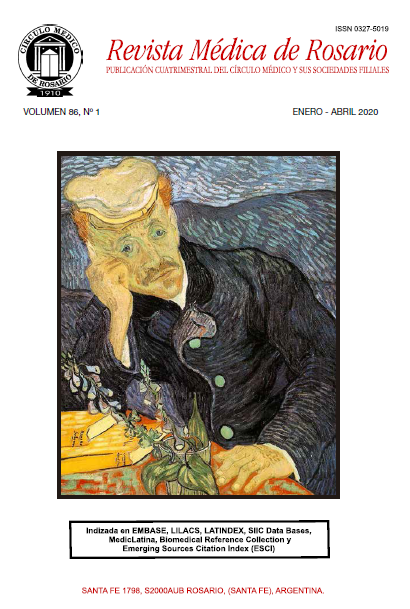The performance of SOAR score as a predictor of severity in acute community-acquired pneumonia
Keywords:
Pneumonia/mortality, Severity of Illness Index, Predictive Value of Tests, Community-Acquired InfectionsAbstract
Objective: To evaluate the performance of SOAR score as a predictor of severity in acute community-acquired pneumonia (CAP), and comparatively with the CURB-65 and Severity Index Pneumonia (PSI).
Patients and Methods: Retrospective, observational, cross-sectional study. It included patients older than 14 years diagnosed on admission as CAP during the period of one year. On admission, CURB-65, PSI and SOAR was calculated. The severity of the CAP was assessed by evaluating the requirement of intensive care, need for mechanical ventilatory assistance or hospital death.
Results: 274 patients, 178 (65,0%) males, mean age 49 ± 18.1 years were included. 62 patients presented bacteremia (22.6%). The microorganism most frequently isolated was Streptococcus pneumoniae (n = 30, 48.4%). The SOAR score was effective to assess ICU admission with an OR = 7.7. CI = 3.8 to 15.6 (p <0.001), and ARM requirement with an OR = 9.9. CI = 4.2 to 23.5 (p <0.001). The SOAR effectively predicted mortality score (p <0.001), with an OR: 12.2 CI 3.9 to 38.1, S: 89.5%, E: 76.5%, VPP: 26.3%, VPN: 98.0% although the PSI and CURB-65 were higher, with an OR: 26.6 and 32.4 respectively.
Conclusion: A point of score SOAR classified as severe (≥2 points) indicates increased risk for severe forms of CAP. The SOAR score can be used as an alternative or complementary way together to essential medical judgment.
Downloads
References
Bartlett JG, Dowell SF, Mandell LA. Practice guidelines for the management of community-acquired pneumonia in adults. Infectious Diseases Society of America. Clin Infect Dis 31:347-82, 2000.
Thomas CP, Ryan M, Chapman JD y col. Incidence and cost of pneumonia in medicare beneficiaries. Chest 142:
-81, 2012.
Fine MJ, Hough LJ, Medsger AR y col. The hospital admission decision for patients with community-acquired pneumonia. Results from the pneumonia Patient Outcomes Research Team cohort study. Arch Intern Me 157:36-44, 1997.
Fine MJ, Smith DN, Singer DE. Hospitalization decision in patients with community-acquired pneumonia: a prospective cohort study. Am J Med 89:713-21, 1990.
Lim WS, van der Eerden MM, Laing R y col. Defining community acquired pneumonia severity on presentation to hospital: an international derivation and validation study. Thorax 58:377-82, 2003.
Niederman MS, Mandell LA, Anzueto A y col. Guidelines for the management of adults with community-acquired pneumonia. Diagnosis, assessment of severity, antimicrobial therapy, and prevention. Am J Respir Crit Care Med 163:1730-54, 2001.
Ewig S, Ruiz M, Mensa J y col. Severe communityacquired pneumonia. Assessment of severity criteria. Am J
Respir Crit Care Med 158:1102-8, 1998.
British Thoracic S, Myint PK, Kamath AV y col. Severity assessment criteria recommended by the British Thoracic Society (BTS) for community-acquired pneumonia (CAP) and older patients. Should SOAR (systolic blood pressure, oxygenation, age and respiratory rate) criteria be used in older people? A compilation study of two prospective cohorts. Age Ageing. 35:286-91, 2006.
Subramanian DN, Musonda P, Sankaran P y col. Performance of SOAR (systolic blood pressure, oxygenation,
age and respiratory rate) scoring criteria in communityacquired pneumonia: a prospective multi-centre study. Age Ageing 42:94-7, 2013.
Fine MJ, Singer DE, Hanusa BH y col. Validation of a pneumonia prognostic index using the MedisGroups
Comparative Hospital Database. Am J Med 94:153-9, 1993.
Mandell LA, Wunderink RG, Anzueto A y col. Infectious Diseases Society of America/American Thoracic Society
consensus guidelines on the management of communityacquired pneumonia in adults. Clin Infect Dis 44 Suppl
:S27-72, 2007.
Boussekey N, Leroy O, Alfandari S y col. Procalcitonin kinetics in the prognosis of severe community-acquired
pneumonia. Intensive Care Med 32:469-72, 2006.
Muller F, Christ-Crain M, Bregenzer T y col. Procalcitonin
levels predict bacteremia in patients with communityacquired pneumonia: a prospective cohort trial. Chest 138:121-9, 2010.
Flanders SA, Stein J, Shochat G y col. Performance of a bedside C-reactive protein test in the diagnosis of communityacquired pneumonia in adults with acute cough. Am J Med 116:529-35, 2004
Holm A, Nexoe J, Bistrup LA y col. Aetiology and prediction of pneumonia in lower respiratory tract infection
in primary care. Br J Gen Pract 57:547-54, 2007.
Fine MJ, Smith MA, Carson CA y col. Prognosis and outcomes of patients with community-acquired pneumonia. A meta-analysis. JAMA 275:134-41, 1996.
Nuorti JP, Butler JC, Farley MM y col. Cigarette smoking and invasive pneumococcal disease. Active Bacterial Core Surveillance Team. N Engl J Med 342:681-9, 2000.
Atlas SJ, Benzer TI, Borowsky LH y col. Safely increasing the proportion of patients with community-acquired
pneumonia treated as outpatients: an interventional trial. Arch Intern Med 158:1350-6, 1998.
Yealy DM, Auble TE, Stone RA y col. Effect of increasing the intensity of implementing pneumonia guidelines: a randomized, controlled trial. Ann Intern Med 143:881- 94, 2005.
España PP, Capelastegui A, Gorordo I y col. Development and validation of a clinical prediction rule for severe
community-acquired pneumonia. Am J Respir Crit Care Med 174:1249-56, 2006.
Vohra AS, Tak HJ, Shah MB y col. Intensive Care Unit Admission With Community-Acquired Pneumonia. Am J
Med Sci 350:380-6, 2015.
Chalmers JD, Singanayagam A, Hill AT. Predicting the need for mechanical ventilation and/or inotropic support for young adults admitted to the hospital with communityacquired pneumonia. Clin Infect Dis 47:1571-4, 2008.
Lim WS, Macfarlane JT. Defining prognostic factors in the elderly with community acquired pneumonia: a case controlled study of patients aged > or = 75 yrs. Eur Respir J 17:200-5, 2001.
Jain S, Self WH, Wunderink RG y col. CommunityAcquired Pneumonia Requiring Hospitalization among U.S. Adults. N Engl J Med 373:415-27, 2015
Published
How to Cite
Issue
Section
License
Licencia Atribución-CompartirIgual 4.0 Internacional (CC BY-SA 4.0)
https://creativecommons.org/licenses/by-sa/4.0/deed.es






